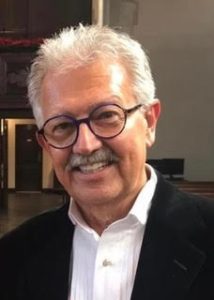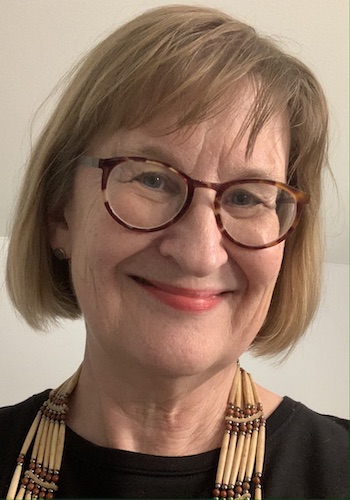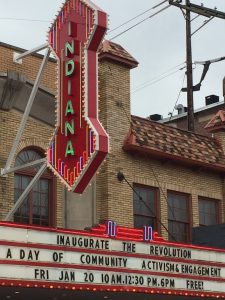
Henry Leck turned to the Arts Alliance to network, develop his painting skills, and show his work. In 2022, he became the organization’s president. | Courtesy photo
Henry Leck spent his life devoted to singing. He taught choral music at Butler for 27 years and founded the Indianapolis Children’s Choir in 1986, leading the organization for 30 years.
In his retirement, Leck decided to take up painting. Among other organizations, he turned to Arts Alliance of Greater Bloomington to network, develop his painting skills, and show his work.
“I got wind of the fact that there was going to be a retail opening called Art Beat over in College Mall,” Leck says. “I went over there and I submitted my things and I was accepted. It is a volunteer kind of organization so I became involved.”
The Arts Alliance of Greater Bloomington has had a few store fronts over the years, from the location on the downtown square to the current shop in College Mall. Art Beat was inside College Mall and operated a few months before COVID-19 hit. The storefront was closed when that section of College Mall became unavailable. The mall’s parent company, Simon Property Group, offered the Arts Alliance a different space, and the organization got to work making it theirs, calling it the Arts Alliance Center.
Little by little, Leck got involved and it snowballed from there. He helped paint the new retail space, then was asked to be on the space committee for the store, and then the “judication committee” for choosing what artwork was shown, and then, in the beginning of 2022, he found himself in the position of president of the entire organization.
In the news, ‘not in a good way’
To effectively tell the story of the Arts Alliance of Greater Bloomington, we must go back to the Bloomington Area Arts Council (BAAC), which formed in 1972 to assist artists and small nonprofit arts organizations in the community. This was pointedly separate from Indiana University. The organization gave grants, provided resources on how to run an arts practice, helped artists and organizations with administrative tasks such as forming an advisory board, and created means of communication for arts leaders in the community. Through the years, some cultural planning and development also fell to BAAC.
Over the course of its existence, the BAAC ran the daily operations of both the John Waldron Arts Center from 1990 to 2010 and the Buskirk-Chumley Theater from 1995 to 2001.

Sally Gaskill, emeritus commissioner of the Indiana Arts Commission and advisory board member of the Arts Alliance of Greater Bloomington. | Courtesy photo
What is now known as the Waldron was originally built in 1915 as a multipurpose building that contained a firehouse, courthouse, and town hall. The city of Bloomington renovated the building and then, in 1990, deeded the property to the BAAC for a new arts space. The renovation fitted the Waldron with space for art classes, gallery shows, and stage performances, as well as general community gatherings.
The Buskirk-Chumley Theater, originally the Indiana Theatre, has been through a lot in its 100 years standing. In 1995, BAAC received the Indiana Theatre as a donation from Kerasotes Showplace Theatres, a national chain based in Chicago.
BAAC renamed the Indiana to the Buskirk-Chumley Theater and began a multimillion-dollar renovation to transform the theater into a performing arts space for the community. The organization set out to raise money; however, it raised only about two-thirds of what it was actively spending on the renovation.
“When I got here to Bloomington, the Bloomington Area Arts Council was on the front page of the news pretty much every day, and not in a good way,” says Sally Gaskill, a lifelong arts administrator. “They were losing money fast, losing staff, losing board members, and the problem was they had been given the Buskirk-Chumley Theater.”
Gaskill was the president of the BAAC from 2000 to 2005. She played an essential role in the transition of the theater from an asset of BAAC to the independent, nonprofit organization it is today under BCT Management Inc.
Iconic buildings going dark
The Bloomington mayor in the early 2000s, John Fernandez, realized there might be two iconic downtown buildings, the theater and the Waldron, that could go dark, due to the BAAC’s financial trouble. The city commissioned a study and formed a recovery plan in response to the findings. Ultimately, BAAC had to give up control of the theater, and BCT Management Inc. was formed in 2001 to run the theater on behalf of the city.

In the early 2000s, two iconic downtown buildings, the Buskirk-Chumley Theater (pictured) and the Waldron Arts Center, almost closed due to financial trouble. | Limestone Post
The BAAC stayed afloat, still managing the Waldron, until 2010, but poor management led to further financial strain.
“The fact that most small nonprofit organizations start from scratch every year — they don’t necessarily have multiyear funding from anyone — is tough,” says Gaskill.
In 2010, the president and small board of directors recognized that the financial strain of the past, as well as high turnover rates in executive leadership positions, left the organization unable to fulfill its mission and purpose. The BAAC decided to dissolve in 2010.
At the time of the dissolution, the Waldron was taken over by Ivy Tech Community College. The center continued to hold art classes, host gallery shows, and stage theater productions. In 2020, Ivy Tech gave ownership of the Waldron back to the city of Bloomington. In July 2022, Constellation Stage and Screen took over management of the building and in August signed a five-year agreement with the city to lease the Waldron.
Before the BAAC dissolved, many in the community felt the organization micromanaged the artists who received grants through the BAAC. A new organization was needed to better serve the needs of artist and arts organizations in the community.
Rising from the rubble
The Arts Alliance of Greater Bloomington formed in August 2010. Artists and art advocates created the organization to be a path for communication and a network of resources for members. The bylaws for the Arts Alliance require a representative on the board of directors from various art forms — visual arts, literary arts, music, dance, and theater — to ensure every art form has an advocate. The recent focuses of this organization have been to connect with other arts organizations in the community, relaunch the online directory, and manage their College Mall shop that houses a gallery front and a “Flex Space” for various projects.

The Arts Alliance’s online arts directory is part of a three-pillar plan to improve resources the Arts Alliance provides to the community.
One of the biggest changes Leck has made within the structure of the organization has been reimplementing the advisory board. He has opened spots to who he says are the “movers and shakers” of arts in the city. Some advisory board members include Gaskill, emeritus commissioner of the Indiana Arts Commission (IAC); Alain Barker, one of the founders of Arts Alliance of Greater Bloomington; Holly Warren, the assistant director for the arts at the city of Bloomington; and directors of the IAC, Buskirk-Chumley Theater, and Constellation Stage and Screen, among other organizations. This change stems from the goal to increase communication among arts organizations in Bloomington and share resources.
Leck reflects on this goal, saying, “My own study in the arts had led me to believe that while some of us learn visually, and some of us learn orally, and some of us learn aesthetically, that with the arts, if you can combine more than one art the impact is stronger.”
An alliance of artists and art advocates
Leck has a three-pillar plan to improve resources the organization provides to the community. First on the list is an online arts directory. The Arts Alliance has been in collaboration with Holly Warren on a new directory. Focus groups Warren has conducted show this resource is a need for the whole community.

Holly Warren, assistant director for the arts at the city of Bloomington and advisory board member of the Arts Alliance of Greater Bloomington. | Courtesy photo
“One thing that’s been really interesting with these focus groups,” says Warren, “is someone will raise their hands and be like, ‘I need this for my kids and I don’t think it exists in Bloomington,’ and somebody on the other side of the room will say, ‘Actually, here are five resources that actually do exist with the city.’ So we just need a platform to connect those resources with people who are expressing those needs. That’s what I’m hoping ultimately this will solve.”
The Arts Alliance launched its new website in September with the arts directory as the focus.
Funding for Arts Alliance programing and website development on this project came from the Bloomington Arts Commission and the IAC. The collective goal is to create a directory anyone can use. Whether the task at hand is to hire a wedding photographer, commission a mural, sign up a middle school student for painting classes, or join a group to network with poets, the arts directory is for artists and art consumers alike.
The second pillar of Leck’s revitalization is the Arts Alliance Center at the mall (between Target and Dick’s Sporting Goods), which opened in 2021. Currently, the front of this space shows and sells artwork created by members and includes a grand piano to promote musical interest, incorporating two of the organization’s main arts areas. The sales floor is rearranged often to include new artwork and new artists. Artists receive 85 percent of the money from their sales and the Arts Alliance Center keeps 15 percent. Behind the sales floor is the “Flex Space,” an area to further include performance art, hold classes, and display special exhibitions juried by other organizations in collaboration with the Arts Alliance.
“The truth is that our mission at the Arts Alliance is not to run a gallery in the mall. That’s a project,” says Leck. “Our mission is to become a networking organization to help support and sustain the arts in the community.”
A more inclusive alliance
Leadership of the organization acknowledges that the work they are doing is just in the beginning stages. Plans are in place to diversify not just art mediums but also the patrons and creatives of the organization, with increased efforts to include those historically underrepresented in the arts.
Another change in members and audience alike is the recent inclusion of IU students. Where the BAAC was founded to be independent from the university art scene, the Arts Alliance of Greater Bloomington never made that specification. Now more than ever, the organization is welcoming younger folks to bring fresh talent on both the creative and administrative sides, another part of Leck’s mission for the organization internally.
The third and next part of Leck’s plan is to create a more vibrant and inclusive arts calendar. On the Arts Alliance website, visitors can already find selected events and can sign up for a bimonthly newsletter that includes community arts events.
Arts and culture flow through the streets of Bloomington like blood in veins. From annual festivals in the heart of town to impromptu ensemble practices on the university green spaces, art of all disciplines has always been a part of the community, and there has always been a community drive to connect with them. Arts Alliance of Greater Bloomington has come a long way from where BAAC started, and the organization has plans to improve and expand even further.
More Info
Arts Alliance of Greater Bloomington: bloomingtonarts.org
Bloomington Arts Directory: bloomingtonarts.org/directory
Contact: info@bloomingtonarts.org
Facebook: @bloomingtonarts
Memberships and Sponsorships
Memberships for the Arts Alliance of Greater Bloomington are $25 for seniors or students, $35 for other individuals, and $45 for organizations. Email member@bloomingtonarts.org with questions.
Sponsorships range from $200 to $500.
Arts Alliance Center
bloomingtonarts.org/aac
in College Mall between Target and Dick’s Sporting Goods
2894 E. 3rd St.
Bloomington, IN 47401
(812) 727-0732
Open Thursday to Saturday 11 a.m.–8 p.m., Sunday noon–6 p.m.


